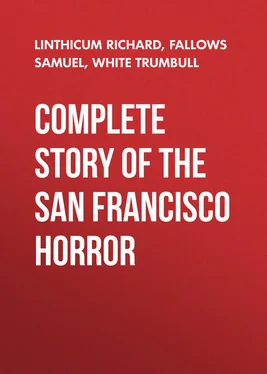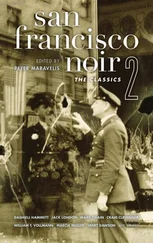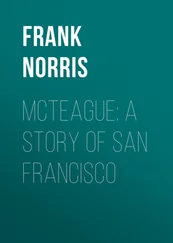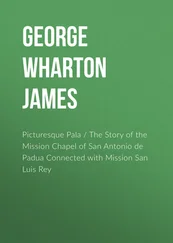Trumbull White - Complete Story of the San Francisco Horror
Здесь есть возможность читать онлайн «Trumbull White - Complete Story of the San Francisco Horror» — ознакомительный отрывок электронной книги совершенно бесплатно, а после прочтения отрывка купить полную версию. В некоторых случаях можно слушать аудио, скачать через торрент в формате fb2 и присутствует краткое содержание. Жанр: geography_book, foreign_antique, foreign_prose, на английском языке. Описание произведения, (предисловие) а так же отзывы посетителей доступны на портале библиотеки ЛибКат.
- Название:Complete Story of the San Francisco Horror
- Автор:
- Жанр:
- Год:неизвестен
- ISBN:нет данных
- Рейтинг книги:4 / 5. Голосов: 1
-
Избранное:Добавить в избранное
- Отзывы:
-
Ваша оценка:
- 80
- 1
- 2
- 3
- 4
- 5
Complete Story of the San Francisco Horror: краткое содержание, описание и аннотация
Предлагаем к чтению аннотацию, описание, краткое содержание или предисловие (зависит от того, что написал сам автор книги «Complete Story of the San Francisco Horror»). Если вы не нашли необходимую информацию о книге — напишите в комментариях, мы постараемся отыскать её.
Complete Story of the San Francisco Horror — читать онлайн ознакомительный отрывок
Ниже представлен текст книги, разбитый по страницам. Система сохранения места последней прочитанной страницы, позволяет с удобством читать онлайн бесплатно книгу «Complete Story of the San Francisco Horror», без необходимости каждый раз заново искать на чём Вы остановились. Поставьте закладку, и сможете в любой момент перейти на страницу, на которой закончили чтение.
Интервал:
Закладка:
But the sacrifice and the labor went for nothing. No human power could stay the flames. As darkness was falling the fire was eating its way through the heart of this residential district. The mayor was forced to announce that the last hope had been dashed.
All the district bounded by Union, Van Ness, Golden Gate, to Octavia, Hayes, and Fillmore to Market was doomed. The fire fighters, troops, citizens, and city officials left the scene, powerless to do more.
On the morning of the second day when the fire reached the municipal building on Portsmouth square, the nurses, helped by soldiers, got out fifty bodies in the temporary morgue and a number of patients in the receiving hospital. Just after they reached the street a building was blown up and the flying bricks and splinters hurt a number of the soldiers, who had to be taken to the out of doors Presidio Hospital with the patients.
Mechanics’ pavilion, which, after housing prize fights, conventions, and great balls, found its last use as an emergency hospital. When it was seen that it could not last every vehicle in sight was impressed by the troops, and the wounded, some of them frightfully mangled, were taken to the Presidio, where they were out of danger and found comfort in tents.
The physicians worked without sleep and almost without food. There was food, however, for the injured; the soldiers saw to that. Even the soldiers flagged, and kept guard in relays, while the relieved men slept on the ground where they dropped.
The troops shut down with iron hands on the city, for where one man was homeless the first night five were homeless the second night. With the fire running all along the water front, few managed to make their way over to Oakland. The people for the most part were prisoners on the peninsula.
The soldiers enforced the rule against moving about except to escape the flames, and absolutely no one could enter the city who once had left.
The seat of city government and of military authority shifted with every shift of the flames. Mayor Schmitz and General Funston stuck close together and kept in touch with the firemen and police, the volunteer aids, and the committee of safety through couriers.
There were loud reverberations along the fire line at night. Supplies of gun cotton and cordite from the Presidio were commandeered and the troops and the few remaining firemen made another futile effort to check the fiery advance.
Along the wharves the fire tugs saved most of the docks. But the Pacific mail dock had been reached and was out of control; and finally China basin, which was filled in for a freight yard at the expense of millions of dollars, had sunk into the bay and the water was over the tracks. This was one of the greatest single losses in the whole disaster.
Without sleep and without food, crowds watched all night Wednesday and all day Thursday from the hills, looking off toward that veil of fire and smoke that hid the city which had become a hell.
Back of that sheet of fire, and retreating backward every hour, were most of the people of the city, forced toward the Pacific by the advance of the flames. The open space of the Presidio and Golden Gate park was their only haven and so the night of the second day found them.
CHAPTER III.
THIRD DAY ADDS TO HORROR
Fire Spreads North and South Attended by Many Spectacular Features – Heroic Work of Soldiers Under General Funston – Explosions of Gas Add to General Terror.
THE third day of the fire was attended by many spectacular features, many scenes of disaster and many acts of daring heroism.
When night came the fire was raging over fifty acres of the water front lying between Bay street and the end of Meiggs and Fisherman’s wharf. To the eastward it extended down to the sea wall, but had not reached the piers, which lay a quarter of a mile toward the east.
The cannery and warehouses of the Central California Canneries Company, together with 20,000 cases of canned fruit, was totally destroyed, as also was the Simpson and other lumber companies’ yards.
The flames reached the tanks of the San Francisco Gas Company, which had previously been pumped out, and had burned the ends of the grain sheds, five in number, which extended further out toward the point.
Flame and smoke hid from view the vessels that lay off shore vainly attempting to check the fire. No water was available except from the waterside and it was not until almost dark that the department was able to turn its attention to this point.
At dusk the fire had been checked at Van Ness avenue and Filbert street. The buildings on a high slope between Van Ness and Polk, Union and Filbert streets were blazing fiercely, fanned by a high wind, but the blocks were so sparsely settled that the fire had but a slender chance of crossing Van Ness at that point.
Mayor Schmitz, who directed operations at that point, conferred with the military authorities and decided that it was not necessary to dynamite the buildings on the west side of Van Ness. As much of the fire department as could be collected was assembled to make a stand at that point.
To add to the horrors of the general situation and the general alarm of many people who ascribed the cause of the subterranean trouble to another convulsion of nature, explosions of sewer gas have ribboned and ribbed many streets. A Vesuvius in miniature was created by such an upheaval at Bryant and Eighth streets. Cobblestones were hurled twenty feet upward and dirt vomited out of the ground. This situation added to the calamity, as it was feared the sewer gas would breed disease.
Thousands were roaming the streets famishing for food and water and while supplies were coming in by the train loads the system of distribution was not in complete working order.
Many thousands had not tasted food or water for two and three days. They were on the verge of starvation.
The flames were checked north of Telegraph hill, the western boundary being along Franklin street and California street southeast to Market street. The firemen checked the advance of flames by dynamiting two large residences and then backfiring. Many times before had the firemen made such an effort, but always previously had they met defeat.
But success at that hour meant little for San Francisco.
The flames still burned fitfully about the city, but the spread of fire had been checked.
A three-story lodging house at Fifth and Minna streets collapsed and over seventy-five dead bodies were taken out. There were at least fifty other dead bodies exposed. This building was one of the first to take fire on Fifth street. At least 100 people were lost in the Cosmopolitan on Fourth street.
The only building standing between Mission, Howard, East and Stewart streets was the San Pablo hotel. The shot tower at First and Howard streets was gone. This landmark was built forty years ago. The Risdon Iron works were partially destroyed. The Great Western Smelting and Refining works escaped damages, also the Mutual Electric Light works, with slight damage to the American Rubber Company, Vietagas Engine Company, Folger Brothers’ coffee and spice house was also uninjured and the firm gave away large quantities of bread and milk.
Over 150 people were lost in the Brunswick hotel, Seventh and Mission streets.
The soldiers who rendered such heroic aid took the cue from General Funston. He had not slept. He was the real ruler of San Francisco. All the military tents available were set up in the Presidio and the troops were turned out of the barracks to bivouac on the ground.
In the shelter tents they placed first the sick, second the more delicate of the women, and third, the nursing mothers, and in the afternoon he ordered all the dead buried at once in a temporary cemetery in the Presidio grounds. The recovered bodies were carted about the city ahead of the flames.
Читать дальшеИнтервал:
Закладка:
Похожие книги на «Complete Story of the San Francisco Horror»
Представляем Вашему вниманию похожие книги на «Complete Story of the San Francisco Horror» списком для выбора. Мы отобрали схожую по названию и смыслу литературу в надежде предоставить читателям больше вариантов отыскать новые, интересные, ещё непрочитанные произведения.
Обсуждение, отзывы о книге «Complete Story of the San Francisco Horror» и просто собственные мнения читателей. Оставьте ваши комментарии, напишите, что Вы думаете о произведении, его смысле или главных героях. Укажите что конкретно понравилось, а что нет, и почему Вы так считаете.












